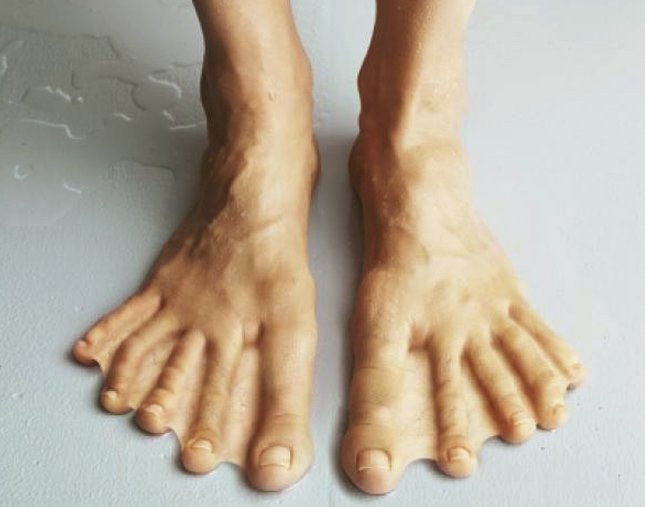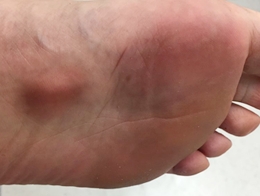Webbed Toes
What Does Webbed Toes Mean?

Webbed toes refer to feet whose toes have tissue in between them, and are medically termed as syndactyly or zygodactyly. Although several animals (like ducks) have webbed feet as part of their normal anatomy, in humans; it is a birth defect. The tissue between the toes is often skin, although in more severe cases, there may be involvement of bones and tendons. Webbed feet usually result from incomplete separation of adjacent toes during development, retaining the embryological form of toes.
Webbed toes may be of several types. They may be cutaneous or they may be bony. This has already been alluded to. Cutaneous webbed feet are frequently referred to as ‘simple webbed feet’. These involve only the skin between two toes. Bony webbed feet are one of the forms of complex webbed feet. Complex webbed feet involve other tissues, like bones, blood vessels and even nerves. They may be partial – where the webbing between the digits covers only a part of the space between the adjacent digits or complete – where the webbing between the digits covers the entire area between the adjacent digits. They may be unilateral or bilateral, meaning they can affect one foot or be present in both feet. If bilateral, they can be symmetrical. For example, webbing between the first two toes in each foot. They can also be asymmetrical; for instance, webbing between the first two digits in the left foot and between the second and the third digits in the right foot. Webbed feet can be extremely mild where there may be no apparent webbing on visual inspection, but there may be noticeable changes in the creases of the toes.
Causes of Webbed Toes
The exact cause of webbed toes is unknown, and it appears to occur randomly without any obvious predisposing factors. It may occur in a healthy child without any family history of webbed feet. The most common factor associated with webbed toes is genetic predisposition with numerous demonstrations of the fact that webbed feet tend to run in families. There are certain patterns of inheritance associated with webbed feet. Taking the example of a family where a mother has webbed feet but the father doesn’t, these patterns of inheritance can be scientifically explained. The most common one being autosomal dominant inheritance, which means that with a mother who has webbed feet and a father who doesn’t; the child will have a high chance of developing webbed feet since the gene inherited from the mother will tend to be expressed regardless of the gene inherited from the father. Another rarer inheritance pattern is autosomal recessive inheritance, whereby the child will only develop webbed feet if he or she receives the involved genes from both parents. Webbed feet are also linked with an X-linked recessive inheritance. This is mostly transmitted to males either from a male who has the genes for webbed feet or a female born of a male with genes for webbed feet. Those individuals who possess these genes are more likely to experience an abnormality in the developmental processes that result in absent or insufficient separation of the toes.
Webbed toes may also be more common among people who suffer from certain diseases that result in abnormal growth, including that of hands and feet. These include Down’s syndrome – which is a genetic disorder and Apert’s syndrome – another genetic disorder that results in abnormal fusion of the bones of the skull. Certain types of autism may also present with syndactyly. Other diseases which may cause one to develop syndactyly include acromegaly (also known as gigantism) and Aarskog syndrome which is quite rare.
Adults may develop webbed toes if their feet are burnt during a fire. The scar tissue formed as a result of the burns sustained, may result in webbing of the toes as the scar causes fusion of the skin of the toes.
Can Webbed Toes be Separated?
Webbed toes can be separated. While the majority of cases of webbed feet only pose an aesthetic challenge, there may be functional challenges associated with severe forms. For example, one may be unable to play certain sports as well as other people. In either of these cases, one may seek to have their webbed toes separated. This is mostly done through surgery as discussed later. Separation of webbed feet allows one to have full functionality of all their digits. It also helps with any psychological trauma or aesthetic problems that one may have. As this is a condition which may be present at birth in most cases, it is possible to have separation done a few weeks after the child is born to ensure that complications are minimized or eliminated. There is great debate and divergence of opinion concerning the exact time that the affected child is required to undergo the surgery. Current practice, however, is that the precise time between birth and surgery is directed by the primary physician of the affected child.
Diagnosis of Webbed Toes
Prenatal diagnosis
Diagnosis can be done in the period before a child is born. Prenatal diagnosis can be done during regular, routine prenatal clinics or if the doctor or the parents suspect there may be something wrong with the baby. A doctor who is aware of any family history of the conditions named above that may cause webbed feet, would ideally have a high index of suspicion. Moreover, people with a history of development of webbed feet in their families may request that the doctor check for these. However, as previously noted, webbed feet can occur in any child as the particular cause is often unclear. The doctor may be able to identify webbed feet from ultrasound scans.
Postnatal diagnosis
Diagnosis made after the child is born is mostly based on physical examination done by the doctor. The doctor inspects the toes and fingers to check for or confirm presence of webbing. If webbed feet are present, the doctor then has to do a more thorough examination to check for other signs and symptoms that may point to the infant having certain syndromes including those mentioned above. The doctor may also use other diagnostic tools including plain radiographs. These images may be required to demonstrate possible involvement of bones in the webbed feet.
How to Treat Webbed Toes?
In most cases of mild partial webbed feet, there is often no need for treatment. This is due to the fact that webbed feet do not usually affect the learning of activities requiring the use of feet. In mild cases, there is often no interference with walking or sporting activities. Some people actually live for many years without feeling bothered by their webbed feet and, therefore, they do not do much about them. However, in more severe cases, surgery may be required.
Surgery
Surgery makes a significant difference offering both physical and psychological relief. The complexity of the surgeries performed depends on the severity of the cases. Also, depending on the number of toes affected, there may be need for multiple surgeries. The surgery cost is covered by several insurance policies. As most webbed toes involve only the skin, the surgery done is simple and uncomplicated. This involves cutting the skin, usually in a zigzag manner and then reattaching the skin on the now separated toes. Often, these surgeries require grafting of skin, that is, taking skin from a different part of the body and placing it on the toes. In cases where skin, bones and tendons are involved, the surgeries done are more complex and more than one surgery may be required to correct the defect. Normal growth ensues after the surgery barring any complications. Surgeries are also done for adults who developed webbed feet following a fire.
Complications
Despite the overwhelming benefits of surgery, there are possible complications that may result from these surgeries. Surgery is associated with the risk of hemorrhage (loss of blood) and adverse reactions to anaesthesia. Other complications unique to these corrective surgeries for webbed feet include:
- Scarring: This may be unsightly and may be counterproductive especially if the reason for surgery was to achieve aesthetic improvements.
- Tissue death: Due to the requirement of skin grafts, there may be reduced blood supply to the introduced skin. This may also be the case in complicated cases where blood vessels are affected. Surgery may result in disrupted blood flow. This may result in tissue death, with a worst case scenario of digit amputation or spread of infection to healthy tissue.
- Recurrence: It is possible for skin to grow back after surgery. This would require further surgery. Altered appearance of the foot. Following surgery, the foot may take on a different appearance. This may be due to the reduced blood supply, the presence of scar tissue or the presence of additional skin.
A cast may be required to allow for proper healing and recovery of the treated foot. A splint may or may not be used after the cast is removed. Following surgery and proper recovery, there may be occupational therapy and physical therapy provided to enable the child or adult function properly with the post-surgery toes.







